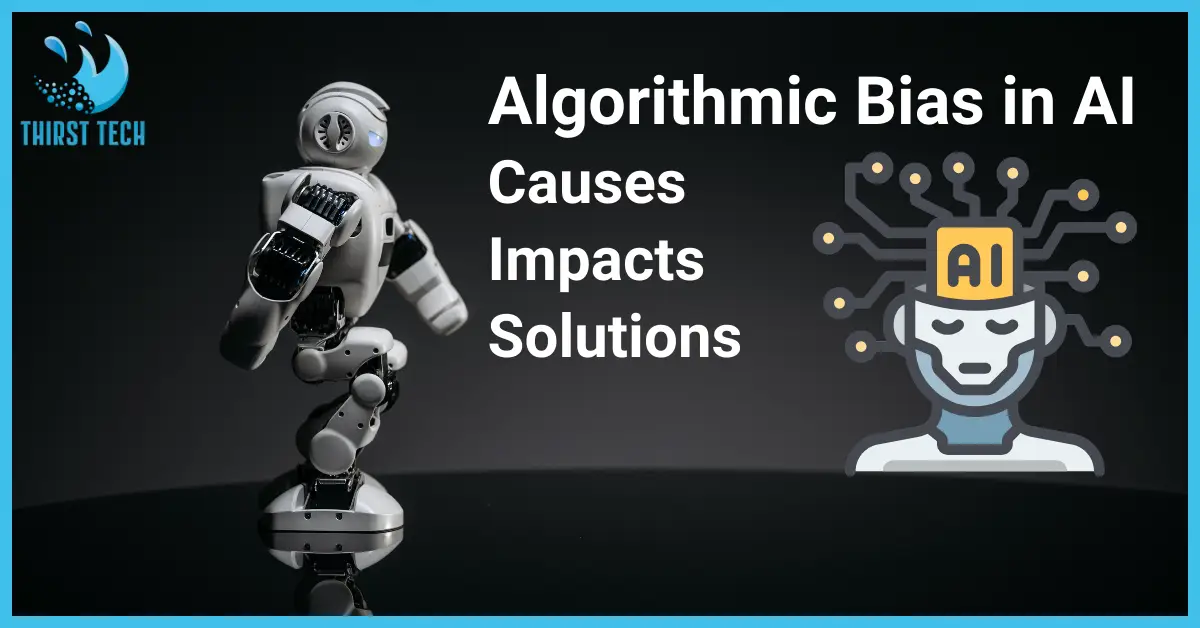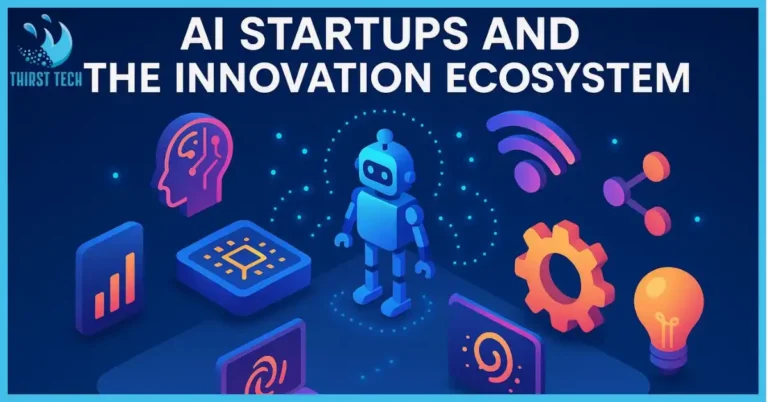What is Algorithmic Bias in AI – Causes, Impacts & Solutions
Algorithmic Bias in AI is a growing threat in our ever-evolving digital world. As businesses increasingly deploy artificial intelligence (AI) systems in their decision-making processes, it is essential to understand what bias actually means in the context of AI, what causes AI bias, and how it may show up in the real world.
This piece examines the nuances of machine learning and algorithmic bias as well as ways of institutionalizing algorithmic bias across multiple sectors of society, along with providing recommended action items for how and why to prevent and mitigate algorithmic bias from affecting people in groups.
Introduction
AI bias, or Algorithmic Bias, refers to a systematic and unfair discrimination that is embedded in AI systems. New analytics from human experts allow us to detect when the machine-learning algorithms we use in so many applications—from healthcare to social media—begin to produce uneven outcomes, minimizing bias while still allowing them to learn from the data presented. This is not just a talk on technical goofiness, it is a discussion on ethical dilemmas, legal loopholes, and social consequences.
Artificial intelligence (AI) developers, data scientists, and policymakers have become increasingly aware of the potential for human bias to infiltrate AI through training data and flawed algorithmic design. With biases evident in decisions as varied as those surrounding hiring, healthcare, criminal justice, and beyond, it is imperative to practice responsible AI to create systems that inspire trust.
🔗 Related Post
Learn how AI Agents function in 2025, from decision-making models to automation, revolutionizing industries with smart adaptability.
Understanding Algorithmic Bias in AI
Definition and Meaning
Algorithmic bias in AI refers to the discriminatory results generated by AI algorithms. These biases can be the result of conscious or unconscious biases caused by faulty data collection methods, training data that do not reflect the diversity of society, or even innate biases within the AI-designed structure.
Essentially, it is an issue where AI bias can also lead to algorithmic discrimination if not properly managed. Results in unjust or uneven treatment of individuals or groups.
Examples and Manifestations
Many industries have witnessed examples of algorithmic bias in their systems. For instance:
- Algorithmic bias in healthcare: Misdiagnoses or unequal treatment recommendations based on skewed data sets.
- Social media algorithmic bias: Social media content curation algorithms that are designed in a way that they confine us in echo chambers making us see things we like to see, but they help in retaining the negative stereotypes in our minds.
- Bias in AI recruiting tools: Automated hiring algorithms that might favor candidates from a specific background and sector, creating gender or racial bias.
These examples demonstrate that bias in Artificial Intelligence is not a problem of one sector and that it can cross-pollinate between different domains of artificial intelligence.
Role of Training Data and AI Systems
The training data used to build an AI model is the backbone of any AI model. If there’s inconsistency or bias in these data sets, the AI system based on them would also inherit these biases. Furthermore, human bias in the creation of algorithms can further worsen the issue by resulting in unintentional discrimination as well. This requires developers to be diligent in their vetting of the data that is employed to train AI models and to ensure that the data reflects a multitude of perspectives.
🔗 Related Post
Discover What Generative AI still cannot do?, from lacking true creativity to missing human empathy in decision-making.
What causes Algorithmic Bias & Where does it come from?
Bias in Training Data
The quality and representativeness of data used in training AI is one of the biggest contributors to algorithmic bias.
- Inadequate data collection: Occurs when data is gathered from limited or unrepresentative sources.
- Historical bias: Past prejudices or inequalities reflected in historical data.
- Sampling bias: Overrepresentation of certain groups while excluding others.
Poor data collection practices introduce skewed data points that shape the decision-making process of the AI algorithm.
Algorithm Design and Development Flaws
Even with good training data, flaws in algorithmic design can introduce bias. Factors include:
- Proxy data: Relying on proxy variables that inadvertently capture bias.
- Flawed model assumptions: Incorrect or oversimplified assumptions during model development.
- Human bias: The unconscious bias of the developers, which might seep into the model.
This calls for responsible AI practices that capture both the technical and human side of AI development.
Challenges In Evaluation and Bias Detection
It has been a tremendous challenge to detect bias in AI, and we are limited in how we can currently evaluate it. Detecting the bias requires a holistic study of the input data as well as the AI system’s decision-making process. The complexity of learning algorithms often means that a form of bias can remain and hide under the surface, requiring continuous tracking and regular algorithmic auditing.
🔗 Related Post
Explore how AI is Transforming Mental Health Care through early diagnosis, personalized treatments, and predictive analytics using machine learning and NLP.
The Risks and Impacts of Algorithmic Bias
Discrimination and Inequality
Unattended algorithmic bias in AI causes serious consequences of algorithmic discrimination and inequality. In areas like healthcare or criminal justice, biased decisions can magnify social inequalities and slowly lead to the discrimination of minority groups. One example might be how AI recruiting can create a lack of diversity in the workplace through biased hiring practices, such as prejudices in hiring for femininity or racism.
Impact on the Legal, Ethical, and Reputational Side
Apart from this, releasing AI systems that are biased can lead to legal issues and a loss of reputation for organizations. Lawsuits, regulatory fines, and public distrust are a few of the potential consequences. This is damaging not just to organizations’ bottom line, but it also hinders the wider acceptance of trustworthy AI technologies.
Impact on Financial and Operations
In the business domain, biased algorithms can have substantial financial implications. Whether it is through erroneous pricing models or flawed financial services, the ripple effects of algorithmic bias in AI can lead to:
- Increased operational costs due to remedial measures.
- Loss of business opportunities occurs when customers lose confidence in the fairness of the system.
- Negative media coverage can impact stock prices and investor sentiment.
🔗 Related Post
Learn how AI is reshaping Transportation and Logistics through smarter routing, predictive analytics, and next-gen supply chain automation.
Real-World Examples and Case Studies
Case Study: Bias in Healthcare
Algorithmic bias in AI in the healthcare sector can lead to unequal treatment recommendations. For example, when data collected predominantly represents one demographic, AI models might misdiagnose or under-treat patients from minority groups. A table below illustrates some common issues and their impacts in healthcare:
| Issue | Impact | Example |
|---|---|---|
| Skewed Training Data | Misdiagnosis in minority groups | Underrepresentation in clinical trials |
| Inadequate Data Collection | Incorrect risk assessments | Limited data on certain genetic markers |
| Lack of Diverse Representation | Unequal treatment recommendations | Bias in treatment algorithms for chronic diseases |
This table underscores how data sets that lack diversity can lead to severe consequences in real-world applications.
Bias in Social Media and Recruitment
Importantly, sexual content lacks the algorithms of AI that drive almost all social media platforms. But the biased data that informs these systems can lead to the amplification of stereotypes and misinformation. Like AI tools that use biased datasets, AI recruiting tools that decide without consideration for human bias may inadvertently favor candidates based on false assumptions about the world, which can lead to fatal flaws of systemic magnitude, such as gender bias or racial bias.
Other Domains Affected by Bias
Other sectors are not immune to algorithmic bias in AI:
- Criminal justice systems: Where biased algorithms can lead to disproportionate sentencing or wrongful convictions.
- Financial services: Bias in credit scoring algorithms can affect loan approvals and interest rates.
- Facial recognition systems: Misidentification and privacy concerns arising from inadequate training data and biased design.
These examples demonstrate the widespread implications of bias in AI system operations.
🔗 Related Post
Dive into How AI Models are Built and Trained, from neural networks to transformers—perfect for both beginners and seasoned developers.
AI Guidelines for Companies: Preventing Algorithmic Bias
We need a multi-pronged strategy that is capable of Addressing Algorithmic Bias in AI. Here are a few ways to identify and reduce these biases.
Diverse and Representative Training Data
Ensuring that data collected for training AI models is diverse is fundamental. This includes:
- Inclusive data collection: Gathering data points from various demographics to avoid bias in ai.
- Regular data audits: Evaluating the data sets for any signs of skew or underrepresentation.
- Updating data frequently: To reflect current trends and avoid outdated big data that perpetuates historical biases.
Bias Detection and Mitigation Techniques
Adopting robust bias detection methods is key:
- Algorithmic auditing: Regular reviews of AI tools and models to detect potential bias.
- Automated bias detection: Utilizing specialized bias detection algorithms to continuously monitor training data and outputs.
- Mitigating algorithmic bias: Implementing corrective measures when bias is detected, including re-training the model with more balanced data used to train the system.
A comparative table of bias detection techniques can be helpful:
| Adjusting the training data to be more representative | Description | Key Benefit |
|---|---|---|
| Manual Auditing | In-depth human review of ai algorithms | Identifies subtle human bias |
| Automated Bias Detection | Use of specialized algorithms to flag bias | Continuous, real-time monitoring |
| Data Balancing Techniques | In-depth human review of AI algorithms | Improves fairness in decision-making |
🔗 Related Post
Discover how AI is Transforming Cybersecurity Defenses through real-time threat detection, smart automation, and proactive risk prevention techniques.
Transparency and Explainable AI
Transparency is essential in addressing algorithmic bias in AI:
- Explainable AI: Making the decision-making process of AI models clear helps users understand how outcomes are derived.
- Open data practices: Sharing training data sources and methodologies builds trust among users.
- Clear documentation: Providing detailed reports on how bias is detected and mitigated reassures stakeholders that the AI system is being responsibly managed.
Inclusive Design and Development
Developing an inclusive AI system requires collaboration:
- Diverse development teams: Diversity can help combat human bias during the design stage.
- User feedback: Engaging a wide range of users in seeking input would help ensure that the system is meeting the needs of minority groups and other vulnerable populations.
- Ethical frameworks: As the gaze on “responsible AI” is everywhere, how do we adopt ethics in the AI development process?
Regulatory and Ethical Considerations
Public concerns have prompted governments and institutions to create regulatory frameworks targeting algorithmic bias:
- Algorithmic Impact Assessments: Assessing the impacts of AI systems on vulnerable communities.
- Compliance with Ethical Standards: Ethics ensure that AI applications comply with ethical standards.
- Collaboration within the Industry: Cooperation with regulators and industry bodies on best practices for the use and deployment of AI systems.
Future Directions and Regulatory Frameworks
Emerging AI Trends & Big Data Technologies
As algorithmic bias in AI may set to be understood by the developments of AI technologies and the constantly changing realm of big data. As AI becomes ubiquitous in everyday applications, ensuring fairness will hinge on:
- Advanced learning algorithms: New methods that can self-correct or flag biases during the development of AI.
- Integration of generative AI: Leveraging innovative techniques to generate more balanced data sets.
- Continuous monitoring: Using real-time analytics to detect and address bias as soon as it occurs.
Algorithmic Impact Assessments
Algorithmic impact assessments are emerging as a crucial tool for evaluating AI systems:
- Pre-Deployment Assessments: Analyzing potential biases before an AI system goes live.
- Monitoring once AI is Deployed: Ongoing monitoring of the model to ensure bias does not change as the model learns from real-world data.
- Stakeholder Engagement: This is to get these experts from many sections to get a complete view of the possible risks.
Building Trustworthy and Responsible AI
The path to trustworthy AI consists of:
- Robust Policies: A set of policies that govern AI developers to abide by ethical standards.
- Transparency in processes: Users are aware of the steps taken against bias detection and mitigation.
- Bias Mitigation Innovation: We are constantly learning about novel bias mitigation approaches that do not imply an impressive computational or memory cost on the learning algorithm.
Conclusion
The problem of Algorithmic Bias in AI is a super complicated one that spools out across data quality, system design, and societal consequences. As AI increasingly shapes what is considered contemporary life, addressing biases has become more than just a technical problem; it is a societal one. Key takeaways include:
- Understand the Problem: Remember that AI bias is a result of training data + human bias on top.
- Causes: From sampling bias to a misguided algorithmic architecture, there are many sources of the problem.
- Solution to reduce the impact: Use diverse data, detect and eliminate the bias, and use transparent AI systems
- Regulatory and Ethical Measures: Develop and adhere to transparency and accountability frameworks.
They are encouraged to adopt a proactive approach by integrating these best practices into their AI system development process. With the rapid pace of change, it’s vital to stay ahead of the curve, both in recognizing potential pitfalls and in actively shaping an equitable digital future.
FAQs
1. How Does AI Cause Algorithmic Bias?
Algorithmic bias in AI discusses the systemic errors of AI systems, which can lead to unfair outcomes, which can arise due to flawed training data and human bias in algorithm development.
2. How can training data introduce bias?
If the data on which a model is trained is not a representative sample of the whole population, the output will reflect that bias. For instance, data disproportionately collected from a single group cannot capture the variety of the nature of society.
3. Examples of algorithmic bias in AI include?
They include algorithmic bias in the health care system, where misdiagnosis or unequal treatment can take place, and people-detecting AI recruiting systems that could reinforce gender bias or racial bias by using unbalanced data sets.
4. How to reduce Algorithmic Bias?
These steps may involve diverse and representative training data, robust bias detection techniques, transparency through explainable AI, and inclusive design practices.
5. Addressing Bias in AI: How do regulations address it?
Algorithmic impact assessments and compliance with ethical codes may be required by regulation, with broad implications for continuous monitoring and evaluation for fairness, which ultimately results in responsible AI.
Sources









